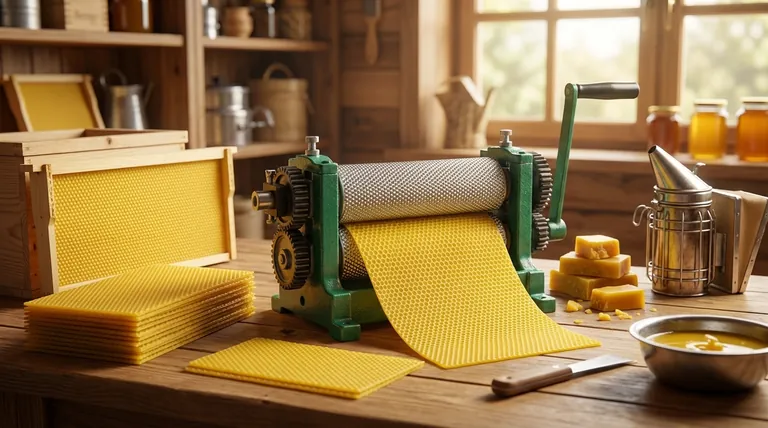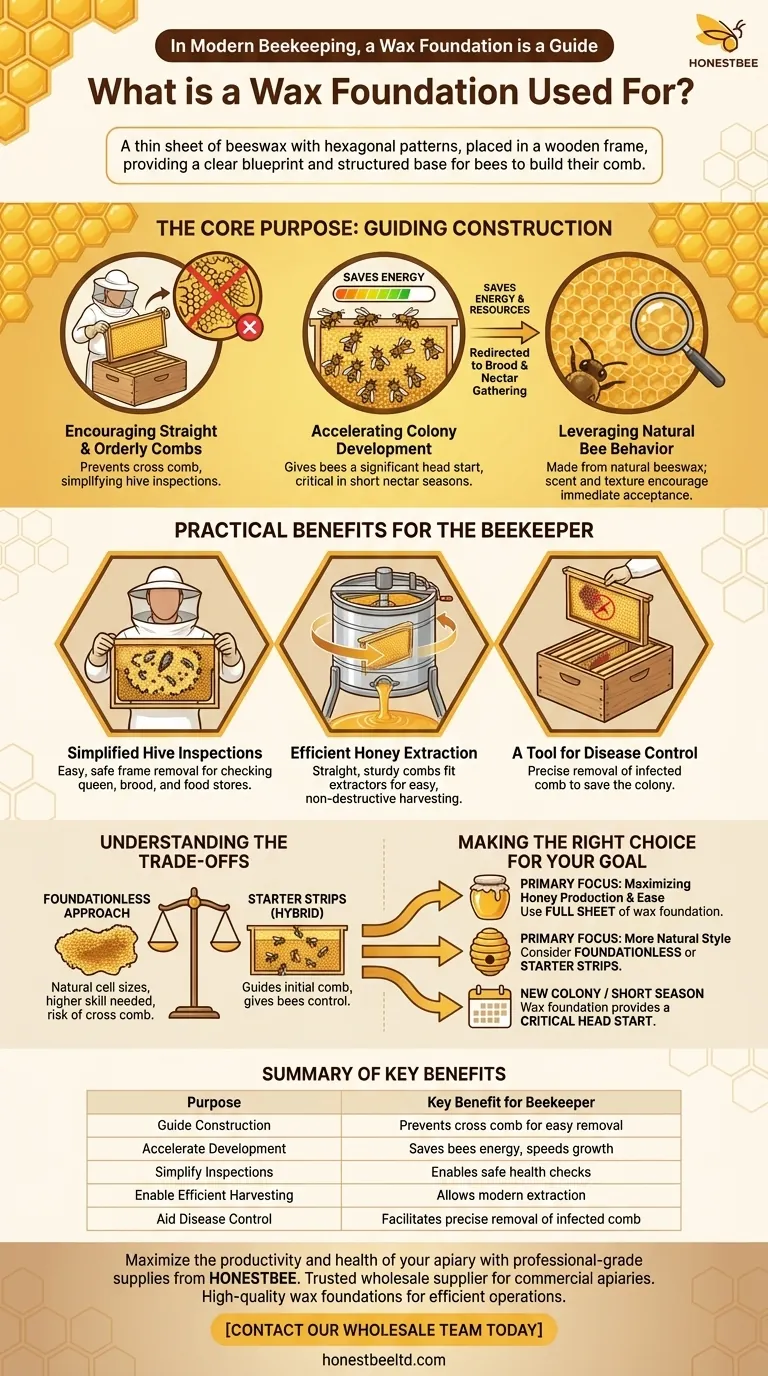In modern beekeeping, a wax foundation is a guide for honeybees. It is a thin sheet of beeswax, imprinted with the hexagonal pattern of a honeycomb, that beekeepers place inside a wooden frame. This sheet provides the bees with a clear blueprint, giving them a structured base on which to build their comb.
The core purpose of a wax foundation is not just to give bees a starting point. It is a strategic management tool that encourages bees to build straight, orderly combs, which drastically simplifies hive inspections and honey extraction for the beekeeper.

The Core Purpose: Guiding Construction
A wax foundation works by channeling the bees' natural building instincts into a pattern that is both efficient for the colony and manageable for the beekeeper.
Encouraging Straight and Orderly Combs
Without guidance, bees may build "cross comb," connecting it between multiple frames. This makes it impossible for a beekeeper to remove a single frame for inspection without destroying the comb and agitating the hive.
A foundation ensures bees build neatly within the confines of each frame, creating a well-organized and accessible hive structure.
Accelerating Colony Development
Building a honeycomb from scratch requires a tremendous amount of energy and resources from the bees. A foundation gives them a significant head start.
The bees can "draw out" the existing cell patterns, saving valuable time that can be redirected toward raising brood and gathering nectar. This is especially critical during short nectar seasons.
Leveraging Natural Bee Behavior
Wax foundations are made from natural beeswax. The familiar scent and texture are highly attractive to bees, encouraging them to accept the foundation and begin work on it almost immediately.
Practical Benefits for the Beekeeper
The guided structure provided by wax foundations translates into several key advantages for hive management and productivity.
Simplified Hive Inspections
With straight, uniform combs, a beekeeper can easily and safely pull out individual frames. This is essential for checking on the queen, assessing brood health, and monitoring food stores.
Efficient Honey Extraction
Modern honey extraction relies on centrifugal force to spin honey out of the combs. This process requires straight, sturdy combs that fit into the extractor without breaking.
Irregular, cross-built combs cannot be used in an extractor and make harvesting honey a much more difficult and destructive process.
A Tool for Disease Control
In the event of a serious disease like American Foulbrood, the entire infected comb must be removed and destroyed to save the colony.
Because the foundation contains the comb to a single frame, it allows for the precise and complete removal of the infected area without compromising the rest of the hive.
Understanding the Trade-offs
While widely used, wax foundation is one of several approaches to comb management, and it's important to understand the alternatives.
The "Foundationless" Approach
Some beekeepers prefer foundationless frames, which allow bees to build their comb with completely natural cell sizes. This is often seen as a more "natural" method, but it requires more skill to manage and carries a higher risk of cross comb.
Customization and Flexibility
Wax foundation does not have to be an all-or-nothing choice. Beekeepers can cut full sheets into smaller "starter strips" and place them along the top of a frame.
This hybrid method encourages bees to build straight down while still giving them control over most of the comb's construction.
Making the Right Choice for Your Goal
Your beekeeping philosophy and objectives will determine the best approach for your hives.
- If your primary focus is maximizing honey production and ease of management: Using a full sheet of wax foundation is the most efficient and predictable method.
- If your primary focus is a more natural beekeeping style: You might consider foundationless frames or using small "starter strips" of wax foundation to guide the initial comb.
- If you are starting a new colony or face a short nectar season: A wax foundation provides a critical head start, saving the bees valuable energy and time when they need it most.
Ultimately, a wax foundation serves as a crucial partnership between the beekeeper and the colony, providing the structure needed for a healthy and productive hive.
Summary Table:
| Purpose | Key Benefit for Beekeeper |
|---|---|
| Guide Construction | Prevents cross comb for easy frame removal |
| Accelerate Development | Saves bees energy, speeding up colony growth |
| Simplify Inspections | Enables safe checks on queen and brood health |
| Enable Efficient Harvesting | Allows use of modern honey extractors |
| Aid Disease Control | Facilitates precise removal of infected comb |
Maximize the productivity and health of your apiary with professional-grade supplies from HONESTBEE.
As a trusted wholesale supplier for commercial apiaries and equipment distributors, we provide the durable, high-quality wax foundations and hive components you need for efficient, large-scale operations. Our products are designed to support your success, from simplifying hive management to boosting honey yields.
Contact our wholesale team today to discuss your supply needs and discover how our solutions can benefit your business.
Visual Guide

Related Products
- Manual Beeswax Comb Foundation Machine Wax Foundation Mill Embossing Machine
- Notebook Style Beeswax Foundation Mould Wax Foundation Mold
- Beeswax Foundation Sheets Beehive Foundation for Wholesale
- Colorful Silicone Beeswax Foundation Mold Mould for Beekeeping
- Professional Frame Preparation: The HONESTBEE Electric Wire Embedder
People Also Ask
- What is the use of a comb foundation mill? Boost Honey Production with Strategic Hive Control
- How should stuck wax on mill rollers be removed? A Gentle, Non-Damaging Cleaning Method
- How do honeybees use wax in their hives? The Key to Colony Survival and Structure
- What is the importance of soaping the rollers during milling? Prevent Wax Adhesion & Equipment Downtime
- What is the function of a beeswax foundation machine? Boost Hive Efficiency and Honey Production


















